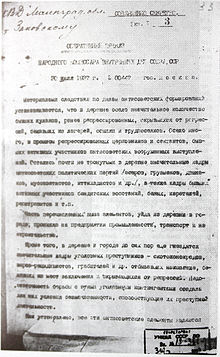NKVD Order No. 00447
This article needs additional citations for verification. (February 2013) |

NKVD Order No. 00447 of July 30, 1937 (
To execute this order, numerous NKVD troikas were created on republican and various regional levels (krai and oblast). Investigation was to be performed by operative groups "in a speedy and simplified way" and the results were to be delivered to troikas for trials.
The chairman of a troika was the chief of the corresponding territorial subdivision of
Protocols of a troika session were passed to the corresponding operative group for executions of sentences. Times and places of executions of death sentences were ordered to be held in secret.
That same order instructed to classify
For example, the
One instance on July 23, 1938, the Omsk NKVD chief named Gorbach requested an increased limit of thousands of more executions, since his men had already fulfilled their plan. The request was approved by Stalin personally, who promoted Gorbach to a larger district. By the autumn of 1937, the pressure to achieve arrests was so great that the NKVD interrogators began picking out names from the telephone directory or preselecting married men with children who, as every agent knew, were the quickest to confess. Within 1939, the system of repression was bursting at the seams—one tenth of the population might be arrested, but not half.[3]
After this Order, the terms First/Second Category became standard abbreviations in NKVD documentation for "the highest measure of punishment" and "placing into corrective labor camps", respectively.
The article III the Order of Conducting the Operation instructed to start the action for securing the anti-Soviet social elements on August 5, 1937 and finish it in four-month term.
The implementation was swift. By August 15, 1937, 101,000 were arrested and 14,000 convicted. By the end of 1938, the NKVD had executed 386,798 Soviet citizens to fulfil order 00447.[4]
References
- ISSN 1961-9898, retrieved 8 July 2010
- ^ The Forsaken, by Tim Tzouliadis pgs. 84-86; pg. 187
- ^ The Forsaken, by Tim Tzouliadis pgs. 84-86; pg. 187
- ISBN 978-0465002399.
